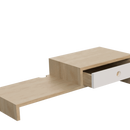Introduction: NOPEINO, the Loose Tenon (Dominoes) Jig
Without a doubt, the introduction of the Festool Domino has been one of the most innovative joinery tools in the last 30 years. The combination ease, precision, speed, and strength of floating tenons basically can't be matched - nothing else this quick is even close to the same strength.
However, as with all Festool products, the Domino isn't exactly cheap. It's not even close to affordable.
Alright, so why do you actually want a Domiono (or NOPEINO)? Mortise & Tenon is a staple joint of furniture and woodworking projects. Being able to do them fast and strong is incredible - in the time you've spent reading down to to here, with a Domino you could have cut all the mortises for the joinery in an end table.
The NOPEINO jig isn't as fast as a Domino, but in the right application it isn't far off. One of the keys with this particular jig is the use of templates that let you use Festools loose tenon stock - this nets you some of the same advantages of the Domino by being able to purchase loose tenons off the shelf rather than having to custom make them every time.
Tools
- Table saw
- Ideally with a dado stack, alternatively router table, or just many passes with a standard blade
- Bandsaw/jigsaw
- Plunge Router
- Guide Bushing
- Drill Press
- 5/16" drill bit
Attachments
Supplies
- Plywood
- 19mm or 3/4" for the jig
- 6mm or 1/4" for templates
- T-Track
- T-Bolt/Knob
- Wood Screws
- Optional flathead machine screws and matching t-nuts
Step 1: Making the Jig - Parts
The jig parts can be made from very little scrap 19mm (3/4") plywood
Here is the cut list, or see the attached PDF.
| Part | Width | Length | Qty |
| Base | 200mm | 400mm | 1 |
| Sides | 150mm | 150mm | 2 |
| Top | 200mm | 300mm | 2 |
| Vertical Fence | 300 mm | 300 mm | 1 |
The templates can be made from 6mm (1/4") plywood.
Step 2: Top Plate
The two parts that make up the top plate measure in at 200x300mm each - for now, keep them as one big part.
Cut a dado half the height (or a hair over) of your t-track, about 20mm in from both edges.
This can be done at the router table with a straight bit, or table saw with a dado stack - either way, it is better to undersize it and sneak up on an exact fit - the t-track will act as both guides and locking mechanism, so this needs to be accurate.
Make one pass, flip the piece, make another pass, then make adjustments.
Step 3:
With the dados routed (or cut), the top plate can be cut in two separating out the fixed and sliding section. For now, the fixed section can be put aside.
The sliding section needs a recess for the template material - again this can be cut at the router table or with the dado stack, removing 6mm deep - or whatever thickness you're opting for your templates.
Once 75mm has been removed, the inner third can be cut away entirely at the bandsaw (or jigsaw, or coping saw)
Step 4:
T-track can be fitted to the fixed portion of the top plate with #4 screws.
A 5/16" hole can then be drilled through the middle of each dado on the sliding plate, approx 30mm in from the edge opposite the template - this is for a 5/16" t-track bolt, but if you're using a different size t-track, drill for the appropriate size there.
The accuracy of the hole isn't overly important, the accuracy comes from the dado the t-track rides in.
Step 5: Base
With the top plate complete, it needs somewhere to sit. The base elevates the plate from the workbench and will eventually give a spot for the workpiece to be clamped to.
- The base is made up of three parts - two 150x150mm sides, and the larger base which is 400x150. The base will overhang and allow space for clamps to hold it to your bench.
- Dados aren't strictly required, but shallow dados do make construction much easier than regular butt joins - alignment is easier and the workpiece tends not to shift when driving screws
Add a dado to the fixed portion of the underside of the top plate for the sides, then matching dados in the large base piece. - You could optionally glue this jig together, but sometimes its OK to just screw things together. So long as you countersink/counter bore the screwheads.
Step 6: Fence
The fence is where the workpieces will eventually be clamped to as they are being routed. Two dados need to be routed for t-tracks to go across the width of the piece. Unlike the t-track in the top plate, this t-track needs to sit below the surface.
Once the grooves are cut, this can be screwed into the base of the jig.
(Note, photo has the jig upside down)
I haven't covered making the stop block for the fence - it just needs to be long enough to span the two t-tracks, with two holes for bolts. Nothing fancy.
Step 7: Templates
The easiest way to make the templates is using my Small Parts Routing Jig (hey, there really is an Instructables for everything!). If you're aiming to use Festool's loose tenons, this needs to be as accurate as possible. If you're making your own, you still want it accurate but you can always resize the tenon stock.
Photo #2 shows the finished result of a template - ideally centered length and width wise on your template stock
Lets assume you're aiming to use a 10mm domino...
Width
You will need to do multiple passes along the width to width slot to accommodate the guide bushing and the appropriate offset. In this case, I'm using a 3/8" or 9.5mm diameter bit, so I'll need to do a second pass taking off 0.5mm extra to give me a 10mm slot.
Length
With the width taken care of, lets address the length. The Domino Slot Length would be 23mm - all of Festool's loose tenons are Cutter Diameter + 13mm. Using a 16mm Guide Bushing and 9.5mm (3/8") bit, the Offset is 6.5mm. Template Length needs to be 23+6.5=29.5mm
This is the somewhat trickier value, but mark your template and use the small parts jig's start/end stops and you shouldn't have any issue. If you overshoot a hair, it isn't a big deal.
See the next step for the rest of the template sizing (to match Festool's loose tenons)
Step 8: Determining Template Sizes
Domino Slot Length = 13mm + Thickness
Offset = Bushing OD - Bit OD
Template Length = Offset + Domino Slot Length
For a 10mm Domino, the Domino Slot Length would be 23mm.
Using a 16mm Guide Bushing and 9.5mm (3/8") bit, the Offset is 6.5mm.
Template Length needs to be 23+6.5=29.5mm
| Desired Domino | Guide Bushing (OD) | Bit | Template Length |
| 5mm | 6.35mm (1/4") | 3.175 (1/8") | 21.17mm |
| 6mm | 6.35mm (1/4") | 3.175 (1/8") | 22.17mm |
| 8mm | 9.5mm (3/8") | 6.35mm (1/4") | 24.15mm |
| 10mm | 16mm | 9.5mm (3/8") | 29.5mm |
Step 9: Usage
The templates can be attached in a variety of ways, from simply screwing it in with woodscrews, to counter boring and drilling for t-nuts and securing with machine screws.
- With your template attached, clamp your workpiece to the table and use the stopblock to help support/square it up.
- Line up the template by adjusting the top plate.
- Place your router onto the jig - the guide bushing goes into the slot in the template. Turn on your router, plunge down to the required depth (10mm domino needs you to plunge about 28mm), and that's really all there is too it.
- This can be used to route into end grain, or into long grain if you reorientate the stop.
If you're joining two pieces of equal thickness, you don't even have to adjust the top plate and everything will line up perfectly!
Step 10: Make or Buy Dominoes
Should you make your own loose tenons or just buy them? You won't get appreciably stronger by making your own, so the question really comes down to cost and availability. Dominos are available in large packets or in 'sticks' that you can cut down - if you're able to pick up a packet from a store without paying for shipping, it likely isn't worth your time setting up machines.
This is especially true of the 5 and 6mm thick dominoes - they're just too small and fiddly, especially with many thicknessers unable to go down to 5mm.
8mm and 10mm, if you're batching out 10+ linear meters can make a bit more sense.
I don't have an Instructables on making your own, but I do have a video!

Participated in the
Woodworking Contest














